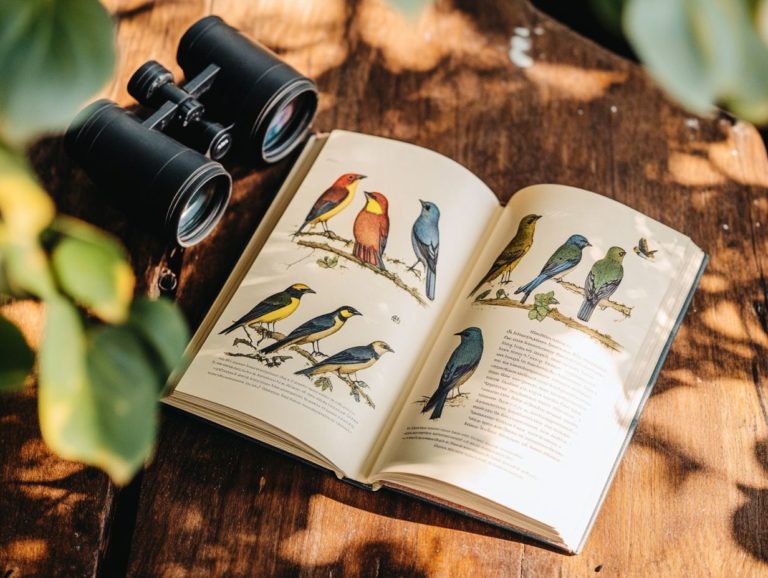Field Guides: Understanding Bird Migration Patterns
Bird migration stands as one of nature’s most captivating phenomena, drawing in both casual observers and seasoned birdwatchers, especially in regions like Nantucket.
Join us as we explore why migratory birds embark on these amazing journeys, the diverse types of migration they engage in, and the remarkable navigation techniques they use.
We will highlight common migration patterns, including those of songbirds and raptors. You will also find valuable tips on how to observe and document these extraordinary events.
Embark on this journey with us as you discover the wonders of avian travel and the secrets these remarkable creatures carry across the skies.
Contents
- Key Takeaways:
- Why Do Birds Migrate?
- Types of Bird Migration
- How Do Birds Navigate During Migration?
- Common Bird Migration Patterns
- How to Observe and Document Bird Migration Using Tools Like Field Guides and Binoculars
- Frequently Asked Questions
- What Are Field Guides?
- How Can I Use a Field Guide to Track Bird Migration Patterns?
- Are There Different Types of Field Guides Available for Understanding Bird Migration Patterns?
- Why is it important to understand bird migration patterns?
- Can I use field guides for other types of animals besides birds?
- Are there any online resources for understanding bird migration patterns?
Key Takeaways:

- Birds migrate for various reasons, such as food availability, climate changes, and breeding purposes.
- Understanding bird migration patterns is crucial for conservation efforts and predicting bird behavior.
- Field guides and resources offer helpful tools for tracking and documenting bird migration, allowing for further study and appreciation of these incredible journeys.
What is Bird Migration?
Bird migration is a fascinating spectacle. Various species embark on extensive journeys across North America, traversing remarkable distances between their breeding and wintering grounds. They are guided by environmental cues like seasonal changes, habitat availability, and food resources.
This complex behavior showcases the special features birds have that help them survive. It also emphasizes their vital roles within different ecosystems. Understanding migration patterns is essential for both conservation and educational initiatives.
Take, for instance, the Arctic tern. It astounds with its incredible round-trip journey of over 70,000 kilometers. Also notable is the majestic monarch butterfly, a non-avian marvel that showcases impressive migratory behavior.
These birds adapt to various environments, from coastal marshes to towering mountain ranges. Their seasonal movements significantly influence local ecosystems through vital processes like plant pollination and seed dispersal.
The timing and success of these migrations are critical. Climate shifts and habitat loss present new challenges. Act now to preserve migratory routes for these birds before it s too late!
By protecting these pathways, you can help ensure that these remarkable birds continue to flourish and maintain the delicate balance within their ecosystems.
Why Do Birds Migrate?
Bird migration serves as a vital survival strategy for many species. It s all about the quest for food availability, suitable breeding habitats, and optimal environmental conditions.
This remarkable journey allows birds to adapt to seasonal changes and sidestep extreme weather that could threaten their survival.
Factors Influencing Migration
Several key factors influence bird migration. Consider the environmental conditions that dictate food availability, weather patterns that can either facilitate or hinder movement, and habitat loss due to human activities, which limits suitable breeding and wintering areas for various species.
As seasons shift, changes in temperature and precipitation can drastically impact when and where birds decide to migrate. For instance, the red-winged blackbird depends on specific wetland habitats, increasingly threatened by urban development and agricultural expansion. This leads to reduced feeding grounds during migration.
Shifting climatic conditions can also disrupt traditional migration routes. Species like the Arctic Tern face altered ocean currents that affect their feeding schedules. The cumulative effects of these environmental changes, combined with human-induced climate change, create significant challenges not just for individual species but for entire avian communities. They strive to adapt to rapidly changing landscapes.
Types of Bird Migration

Bird migration in North America falls into two main categories.
Seasonal migration is when birds move between their breeding and winter homes, seeking favorable climates. Year-round migration occurs when specific species remain in one area, skillfully adapting to their local environments throughout the year.
Seasonal vs. Year-Round Migration
Seasonal migration involves birds moving between their breeding and wintering grounds in response to ever-shifting environmental conditions. In contrast, year-round migration features species that maintain a consistent presence in their habitats, adapting their behaviors to local food availability and habitat conditions.
The Arctic Tern embarks on an incredible journey, traveling thousands of miles from its Arctic breeding grounds to the warm embrace of the Antarctic for winter. During this journey, it swiftly transitions its diet from fish in chilly waters to smaller prey found in temperate regions.
Consider the House Sparrow, which embodies year-round migration. This adaptable bird stays locally throughout the year, thriving in urban environments where food is abundant and breeding sites are easily accessible. These birds skillfully balance their life cycles with environmental changes, showcasing their unique adaptations to climate, food availability, and habitat preferences.
Birds have mastered the art of navigation during migration, utilizing a fascinating array of navigation techniques. They expertly harness celestial navigation, relying on the sun and stars, and orient themselves towards geographic landmarks.
In recent years, they ve begun to benefit from advancements in technology, such as geolocation, which helps track animal movements using satellites. This combination of instinct and innovation allows them to traverse vast distances with astonishing accuracy.
Birds employ a sophisticated blend of navigation techniques, utilizing celestial navigation based on the sun and stars, alongside the recognition of physical landmarks. Modern tracking tools, utilizing advanced geolocation technology, enhance the study of their migratory routes and behaviors.
Many species also use the Earth’s magnetic field as a guiding compass, sensing magnetic cues through specialized cells in their eyes. Take the European Robin, for instance; it has been the subject of extensive research regarding its remarkable ability to navigate using geomagnetic fields.
Studies show that birds can adjust their migration routes based on magnetic cues, enabling them to traverse thousands of miles with impressive precision.
With the advent of modern technologies like GPS tracking and satellite imaging, scientists can gather real-time data on migratory patterns. This reveals intriguing insights into how diverse species, like the Arctic Tern and the Bar-tailed Godwit, strategically employ these cues during their lengthy journeys.
Common Bird Migration Patterns

Common bird migration patterns among North American birds reveal a fascinating array of migratory routes and behaviors. To better understand these patterns, identifying bird species involves recognizing how different species skillfully adapt to seasonal movements shaped by factors such as climate, food availability, and changes in habitat.
These adaptations are vital for their survival and play a crucial role in their population dynamics.
Examples of Well-Known Patterns
Take a moment to appreciate the awe-inspiring bird migration patterns in North America. The annual journey of the Whooping Crane (Grus americana) and the Sandhill Crane (Antigone canadensis) showcases extraordinary endurance and navigational skills.
These remarkable birds travel thousands of miles between their breeding and wintering grounds, highlighting their natural abilities. Their impressive migration routes not only reveal their reliance on specific signals from nature, including changes in daylight and temperature, but also their ability to fly long distances without a break. For example, the Whooping Crane migrates from breeding grounds in Canada to wintering sites in Texas, typically between late March and early April. In contrast, the Sandhill Crane embarks on a similar trek but often chooses nesting areas across the Northern Great Plains.
As they adapt to various environmental challenges, these birds depend on wetlands and grasslands to provide vital feeding and resting spots along their journeys. Their survival is intrinsically linked to the availability of these habitats, rendering them particularly sensitive to changes in weather and human actions.
How to Observe and Document Bird Migration Using Tools Like Field Guides and Binoculars
Observing and documenting bird migration can be an incredibly fulfilling experience for you as a birdwatcher! It calls for the use of field guides, mobile apps like Merlin Bird ID, and various resources to accurately identify and record migratory species during their seasonal journeys.
Birdwatching is a thrilling adventure! It deepens your understanding of bird behaviors and their interactions with nature.
Best Practices and Resources for Field Guides
Utilizing the best practices and resources for field guides in birdwatching significantly enhances your identification process. You can leverage digital resources like the Merlin Bird ID app, alongside traditional books such as the Sibley Guide to Birds and Stokes Field Guide. This combination will undoubtedly improve your observational skills and deepen your knowledge of migratory birds.
By integrating these tools into your birdwatching practice, whether you’re a novice or a seasoned birder, you can create a more enriching experience while exploring your natural surroundings. As a beginner, you’ll find immense value in user-friendly apps that offer sound identification and range maps, perfectly complementing your enthusiasm with interactive learning. Meanwhile, experienced watchers can dive into specialized field guides, utilizing advanced features for thorough analysis and documentation.
Join local birdwatching clubs! It’s a fantastic way to connect with others, share knowledge, and elevate your birdwatching experience.
Frequently Asked Questions

What Are Field Guides?
Field guides are essential resources that help you identify bird species, providing illustrations and details about bird behavior, habitats, and migration patterns. For a deeper dive, explore understanding bird identification with field guides.
How Can I Use a Field Guide to Track Bird Migration Patterns?
There are different ways to use a field guide to track bird migration patterns. Start by familiarizing yourself with the various species of birds that migrate in your area and their distinctive markings. To enhance your understanding, consider understanding bird behavior with field guides. Observe the birds you see and compare them to the illustrations in the field guide. You can also record your observations and compare them to migration maps to track the patterns of different bird species.
Are There Different Types of Field Guides Available for Understanding Bird Migration Patterns?
Yes, there are various types of field guides available, including print and digital versions. Some field guides focus on specific regions or habitats, while others cover a wide range of bird species. There are also specialized field guides for different levels of bird watchers, such as beginners, intermediate, and advanced.
Why is it important to understand bird migration patterns?
Understanding bird migration patterns is vital now more than ever. It s key to protecting our wildlife in the face of climate change.
By tracking their movements, scientists can identify important stopover sites and breeding grounds. This also helps in recognizing potential threats to their migration routes.
This information is vital for creating effective conservation plans to protect migratory birds.
Can I use field guides for other types of animals besides birds?
Yes, field guides are commonly used for birds but are also useful for other animals. You can use them for mammals, reptiles, and insects too.
These guides provide information and illustrations of different species, their behaviors, and habitats. They can also help in understanding what to know about bird migration patterns.
Are there any online resources for understanding bird migration patterns?
Yes, there are many online resources for understanding bird migration patterns. Websites, blogs, and social media pages offer valuable information.
These resources often include migration maps and sightings data. Explore these resources today! They can help you track incredible bird migrations.






